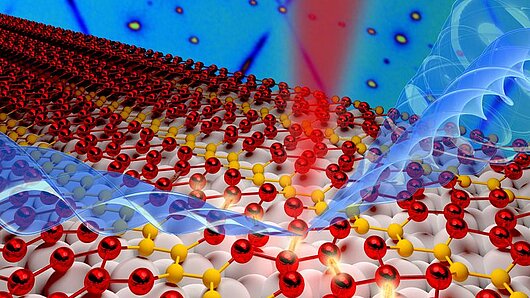High-Performance Computing Center Stuttgart

Recently a team of materials scientists led by Prof. Dr. Wolf Gero Schmidt at Paderborn University became interested in investigating phase transitions on the surfaces of materials. Previous research had shown that phase transitions inside bulk materials can occur within several picoseconds (one picosecond is one trillionth of a second) though it was thought that such changes on surfaces must take much longer. Because surfaces are exposed to the surrounding environment, understanding the physics behind surface phase transitions could have a variety of interesting applications, such as for the development of new kinds of sensors and detectors.
In the lab the scientists affixed wires made of the element indium to a silicon substrate. The wires were extremely thin — just four atoms wide by one atom in height. At room temperature the wires are metallic and able to conduct electricity, though when cooled below 120 K (-150 °C) they undergo a phase transition in which the indium atoms rearrange into hexagonal structures and the wires become insulating.
The scientists first cooled the system to 30 K (-243 °C) and used a technology called electron diffraction to observe how electrons scattered when bounced off the wires. They then compared this pattern to what happened when a laser pulse was combined with the electron pulse. Physicist Tim Frigge at the University of Duisburg–Essen determined that when the delay time between pulses of light was greater than 350 femtoseconds, the diffraction pattern changed to become the same as that of the conducting wires. From a physical perspective, this meant that the indium atoms on the surface of the silicon must be able to rearrange themselves within just 350 quadrillionths of a second, a speed that is at the very limit of what quantum mechanics permits.
As Dr. Schmidt explains, "What is truly remarkable is that this phase change occurs not because of heat, but in response to light even while the atoms are still extremely cold. Inducing this kind of phase change through heating would require time lengths that are orders of magnitude longer."
In order to understand how such a rapid phase change could occur in the absence of thermal heating the scientists turned to computational modeling, using Hazel Hen, the heart of the high performance computing platform operated at the HLRS – High Performance Computing Center Stuttgart, as well as computational resources at Paderborn University.
Computational simulations of molecular dynamics were essential to studying this problem because of the large numbers of optically excited electrons and atoms involved in the phase change. The simulations revealed that indium electrons become excited to a higher energy state by the laser pulse. This creates new bonds and breaks some of the original chemical bonds between the indium atoms, causing the atoms to move. These movements eventually change the electronic properties so that the wire becomes a conductor. The simulations also revealed that the energy carried by the laser soon becomes dissipated into the silicon, trapping the indium wires in a metallic state.
The scientists were also curious to understand how anchoring the indium wires in the silicon base affects the phase transition. Using the supercomputer they were able to model numerous possible scenarios of how excited electrons, as well as the indium and silicon atoms, might behave when exposed to the light pulse. These simulations enabled the investigators to exactly model the excitation scenario observed experimentally. In addition, the calculations predict that anchoring the indium wires to different substrates could slow down or even further speed up the phase change. In the future this could enable materials scientists to control the speed of the phase transition.
In practical terms the scientists believe that such a system could potentially serve as a basis for smart materials that react in predictable ways to changing conditions or environments. Considering the speed of the phase transition they were able to describe, such an approach could enable, for example, the development of optical-electronic sensors that identify and report on changes in a system at extremely small time scales. Indeed, the system characterized by the authors of the Nature paper might constitute the fastest electronic switch ever observed.